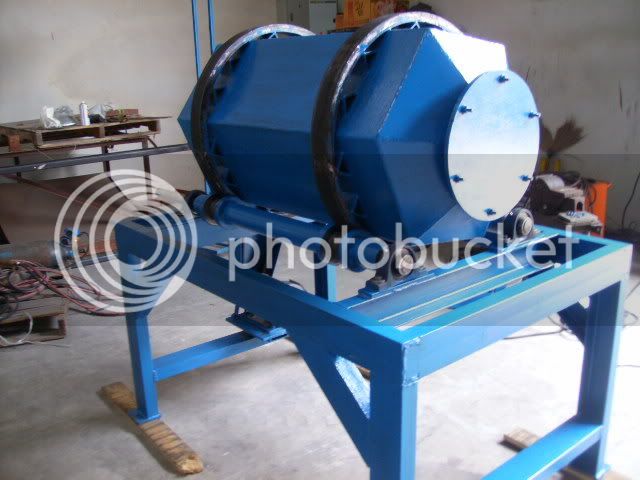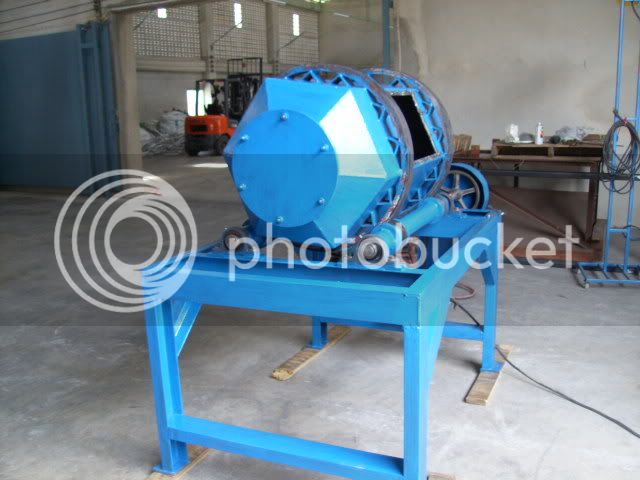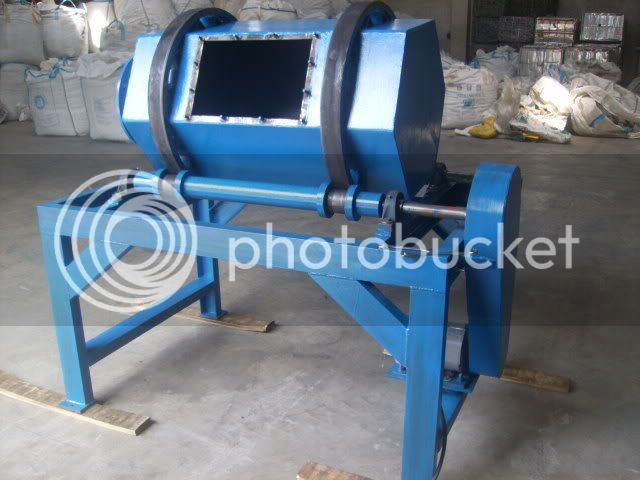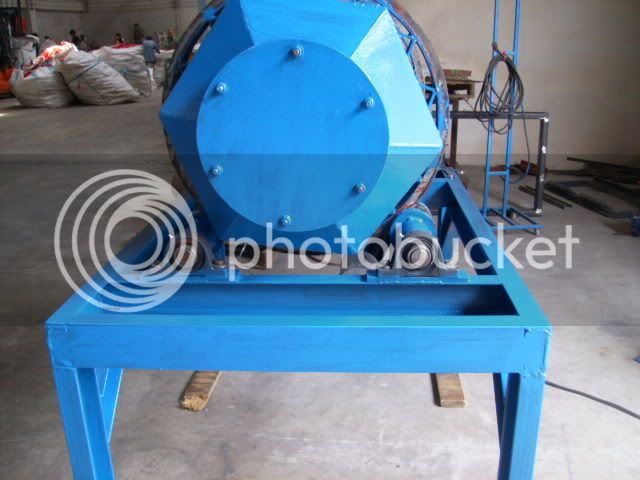I'm attaching some pictures, with explanation.
Basically, I'm guessing that I've run this thing for a total of 100 hours. In that time, I've pulverized probably 600 lbs. total of electronics. I had the tumbler and hoops built by a local welder, but did the rest myself.
Catalytic biscuit goes 'fast'. The first time I ran it, it brought 150 lbs. of biscuit down to <50 in an afternoon.
PC board takes much, much longer. I guess, I'm looking into processing just straight ceramic components, off the PC board, or with PC board kept to an absolute minimum.
When starting a batch of PC board, I make sure that the pieces are about the size of playing cards, or smaller. I load 150 lbs. or so into the tumbler, and add another 70 lbs. large ball bearings, steel machine screws, etc.
After running for 36 Hours or so, I empty the contents onto a chicken-wire sieve. All the larger pieces of steel, plastic, and PC board get pulled out, at this point, as long as their components are removed. Otherwise, back into the mill. The stuff that goes through the sieve goes immediately into my trash-can shaker (not shown), 100 mesh. If it doesn't go through the sieve, back into the machine.
I can't stress enough how important it is NOT TO BREATHE ANY OF THE DUST produced by this thing, when emptying it. This isn't so much of a problem when running it, because there's a gasket on the lid. I wear an air mask whenever I'm near this thing, but even so, I had a startle when at my last Dr. visit, my blood Pb and As levels came up 2x normal. Now, I'm more cautious than ever. Ear plugs are required equipment, too.
Here are some specs, all approx:
tumbler dimensions: 30" x 20". The individual sides of the prism are stitch-welded from 28" x 10" plates. I had to reinforce the hoops with little spokes made from scrap pipe, because the hoops kept breaking at the vertices. The hoops are cushioned by 4 belts (I forget the size).
tumbler material: 3/32" steel plate **CORRECTION: 3/16" plate
Weight, entire unit with motor, bed, empty: approx 150 lb.
Weight, full and running: 350 lb
shafts: 1" diameter
chain, pulley, and sprockets: chosen to give a steady 1 RPS of the main drum. Faster than that, and the machine acts up, breaking belts, or bouncing. [corrected, thanks Carlos - not 1 RPM !!]
rollers: 3" diameter; mounted on 4 pillow blocks. I needed to put on an additional bearing where the shaft comes directly from the large pully wheel, because the 1" shaft repeatedly sheared off right at this point. So the power really doesn't go directly go to the chain where the pulley is attached.
motor: 1/3 HP 120 v. ; the motor is mounted with a pair of door hinges.
Basically, I'm guessing that I've run this thing for a total of 100 hours. In that time, I've pulverized probably 600 lbs. total of electronics. I had the tumbler and hoops built by a local welder, but did the rest myself.
Catalytic biscuit goes 'fast'. The first time I ran it, it brought 150 lbs. of biscuit down to <50 in an afternoon.
PC board takes much, much longer. I guess, I'm looking into processing just straight ceramic components, off the PC board, or with PC board kept to an absolute minimum.
When starting a batch of PC board, I make sure that the pieces are about the size of playing cards, or smaller. I load 150 lbs. or so into the tumbler, and add another 70 lbs. large ball bearings, steel machine screws, etc.
After running for 36 Hours or so, I empty the contents onto a chicken-wire sieve. All the larger pieces of steel, plastic, and PC board get pulled out, at this point, as long as their components are removed. Otherwise, back into the mill. The stuff that goes through the sieve goes immediately into my trash-can shaker (not shown), 100 mesh. If it doesn't go through the sieve, back into the machine.
I can't stress enough how important it is NOT TO BREATHE ANY OF THE DUST produced by this thing, when emptying it. This isn't so much of a problem when running it, because there's a gasket on the lid. I wear an air mask whenever I'm near this thing, but even so, I had a startle when at my last Dr. visit, my blood Pb and As levels came up 2x normal. Now, I'm more cautious than ever. Ear plugs are required equipment, too.
Here are some specs, all approx:
tumbler dimensions: 30" x 20". The individual sides of the prism are stitch-welded from 28" x 10" plates. I had to reinforce the hoops with little spokes made from scrap pipe, because the hoops kept breaking at the vertices. The hoops are cushioned by 4 belts (I forget the size).
tumbler material: 3/32" steel plate **CORRECTION: 3/16" plate
Weight, entire unit with motor, bed, empty: approx 150 lb.
Weight, full and running: 350 lb
shafts: 1" diameter
chain, pulley, and sprockets: chosen to give a steady 1 RPS of the main drum. Faster than that, and the machine acts up, breaking belts, or bouncing. [corrected, thanks Carlos - not 1 RPM !!]
rollers: 3" diameter; mounted on 4 pillow blocks. I needed to put on an additional bearing where the shaft comes directly from the large pully wheel, because the 1" shaft repeatedly sheared off right at this point. So the power really doesn't go directly go to the chain where the pulley is attached.
motor: 1/3 HP 120 v. ; the motor is mounted with a pair of door hinges.











